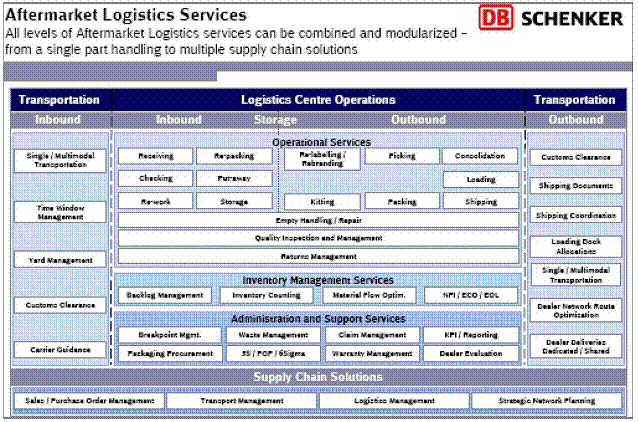DB Schenker Expands Contract Logistics
April 19, 2010
By
Richard Armstrong
Taking exception to the current economic turmoil, DB Schenker Contract Logistics/SCM is hiring and expanding. Dr. Detlef Trefzger, member of the board of management for Contract Logistics/SCM of DB Schenker Logistics, has kicked off DB Schenker’s “Go-for-Growth” program announcing that the company will hire 200 new top staff members as part of an expansion to nearly double revenues over the next few years.
In the Americas, the effort will be led by David Bouchard, chief operating officer of DB Schenker Logistics for the region. Bouchard, a highly respected industry exec, previously spent several years at Ryder. He has extensive experience in Latin America, especially in Mexico and Brazil.
DB Schenker’s Canadian operations have been strong for a decade.¹ In 2004, Schenker purchased North Carolina based CCW and began expanding contract logistics in the U.S. This expansion has proceeded quietly but strongly. Schenker Logistics now has 12 million square feet of warehouse space and 3,500 employees in Canada and the U.S. There are 32 locations in the U.S. Twenty-five are single client dedicated facilities; seven are multi-client. Key multi-client operations are in Los Angeles, San Francisco, Dallas, Indianapolis, Miami, and Greensboro. In Canada, operations are consolidated around Toronto and Vancouver.
DB Schenker’s North American business is currently dominated by Consumer and Electronics accounts which constitute nearly two-thirds of revenue. The other third is spread over Automotive, Industrial and Supply Chain Services such as LLP (lead logistics provider) services. This profile contrasts with the overall German based operations where Automotive and Chemicals are major verticals along with Electronics. DB Schenker provides production support, finished car and spare parts work globally for a host of well known companies.
Table 1. DB Schenker’s Automotive Accounts
|
Aisin |
Bosch |
BMW |
|
Delphi |
Ford |
Kautex |
|
Kia |
Mercedes Benz |
NAZA/Peugeot |
|
Nissan |
Nokian |
Porsche |
|
Proton |
Sypka |
VW |
Automotive work in the Americas is limited to Ford, BMW and VW
North American Consumer accounts include Procter & Gamble (4 facilities), Kraft (3 facilities), and Unilever (2 facilities). These dedicated facilities are big box, pallet and case, multiple product operations with significant volume throughputs. Schenker also runs six facilities for DuPont.
Figure 1. DB Schenker’s North American Customers

DB Schenker’s major competitor on Consumer accounts is DHL/Exel Supply Chain. Not

Océ – Columbus, Ohio USA
Attendees:
Theresa Foran, Director – Contract Logistics Strategy
Brian Leja, General Manager
Tom Perry, Director – Industrial
Océ grosses $3.7 billion a year in revenue, has 22,000 employees and operates globally. Its major product lines are office copiers and large format and production printers. It also provides supplies and technical support for all products.²
DB Schenker opened in Columbus for Océ in 2003. In 2005, Océ purchased Imagistics with its copier and fax based product lines. The Columbus Mega Center (CMC), now operated by DB Schenker for Océ, is 217,000 square feet. Extensive use is made of “pick to light” carousels and pick lines. Océ has employees onsite who customize copiers as orders are received.

The CMC was consolidated from three separate U.S. facilities. It has high quality IT including an Exceed (Infor) WMS and integration to Océ’s SAP and Oracle systems.
From Columbus, DB Schenker supports 26 Océ dealers and end users of Océ products. There are seven regional distribution centers (RDCs) including Columbus. These RDCs specialize in “white glove” deliveries. Service technicians operate from home or from sales/service branch offices. Normally, they have “trunk stock” and call the RDCs as necessary. Trunk stock is maintained with weekly standard orders. Old Océ machines are returned to the RDCs.
For the printer network, forward stocking locations (parts deports) are maintained throughout the U.S. Technicians often meet tight time windows for emergency repairs. Emergency orders are order today – deliver tomorrow, while stock replenishments are normally shipped within 24 hours.
Figure 3. DB Schenker’s Aftermarket Logistics Services

Within the CMC is a radio frequency facility. Brian Leja’s personnel pick an average of 4,200 lines a day for 2,000 orders. Also there are a few dozen adapted copier and fax orders plus large, regular orders to dealers.
Parts received are broken down to totes and moved to carousels. (Some orders include small pieces like a single, one inch spring.) Pallets of supplies like toner are stored in racks and then moved to pick lines or staging locations as necessary depending on order sizes. There are 28,000 SKUs (stock keeping units) warehoused.
There are three daily shifts at the CMC. The first shift picks most outbound orders. The second shift handles most emergency and next day air (the FedEx cut-off is 10:50 P.M.). Wave picks are utilized for all picking processes. In order to manage volumes better, 10-hour shifts are run on Wednesday and Thursday. Conveyors, with tote label auto reading, forward products to the right final packaging areas.
Ninety-five percent of shipments are tendered to FedEx and UPS. Dealer shipments are primarily less than truckload (LTL). There are three to four next flight out (NFO) shipments a day.
Seventy percent of parts are picked from carousels. There are 26,000 bin locations. Items to be picked have ABC ordering to allow for “snake picking”.
This operation uses standard Schenker quality improvement processes with an emphasis on quarterly KAIZEN improvements.
ABC cycle counting is done by the third shift. “A” products are counted once a quarter, “B” products twice a year and “C” products once a year.
Based on DB Schenker’s internal scorecard, the CMC is a Best in Class operation. It is one of the top five in North America. For 2009, on-time shipping was 99.99%. On-time receipt by users/dealers was 98.0%. Order accuracy was 99.9%. On-time putaway was 99.1%. Fill rates are 99.0% or more. Mighty impressive statistics!
Modelling, Planning and Process Design
Business solutions design is handled at Schenker’s headquarters in Atlanta by Sean Kelly. In addition to creating flow changes and implementation schedules in process design, Kelly and his staff use a variety of sophisticated tools.
CAST – Global Supply Chain Network Modelling*
Widely recognized as one of the leading solutions in market, CAST functionality facilitates global supply chain network modelling with mapping, locations and road network databases for any combination of regions or global approach.
Supply Chain Modeller*
This internally developed simulation tool, offers an interactive way to test and analyze different logistic scenarios including aspects such as different modes of transportation, lead times, service levels, warehousing and inventory.
LoCaTo – Logistics Cost Calculations
The “Logistics Calculation Tool” is an internally developed tool for cost calculation of logistics business processes. This supports the analysis of warehouse activities when finding operational alternatives: Consolidation vs. Deconsolidation Scenarios, Inventory vs. Cross Dock Operations, etc.
CLASS – Warehouse Layout Design and Operation Simulation
Computer Layout and Simulation Software – a high-end tool used for warehouse layout design, operation simulation and KPI (key performance indicator) reporting to design the optimal facility. It ensures a correct balance and optimization of cost, service and on-going efficiency, and that staff and MHE (material handling equipment) resources are optimized. It also allows new facilities to be stress tested in a safe environment prior to go-live.
*When required
¹See our Schenker Toronto, Canada site visit case study report Putting Global Supply Chain Links Together at https://www.3plogistics.com/Schenker_6-2004.htm.
²Canon bought Océ on March 19, 2010.
Sources: A&A Primary Research, https://www.dbschenker.com/


